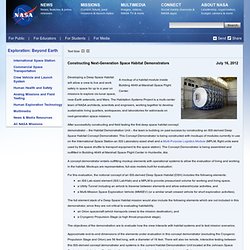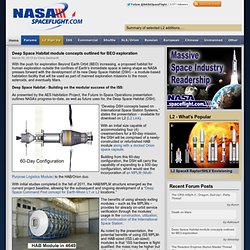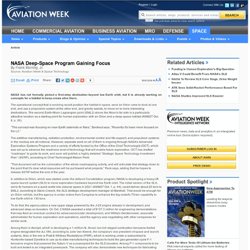

Constructing Next-Generation Space Habitat Demonstrators. Developing a Deep Space Habitat will allow a crew to live and work safely in space for up to a year on missions to explore cis-lunar space, near-Earth asteroids, and Mars.

The Habitation Systems Project is a multi-center team of NASA architects, scientists and engineers, working together to develop sustainable living quarters, workspaces, and laboratories for astronauts on next-generation space missions. Deep Space Habitat module concepts outlined for BEO exploration. March 30, 2012 by Chris Gebhardt With the push for exploration Beyond Earth Orbit (BEO) increasing, a proposed habitat for human exploration outside the confines of Earth’s immediate space is taking shape as NASA presses forward with the development of its new Deep Space Habitat (DSH) – a module-based habitation facility that will be used as part of manned exploration missions to the moon, asteroids, and eventually Mars.

Deep Space Habitat - Building on the modular success of the ISS: As presented by the AES Habitation Project, the Future In-Space Operations presentation outlines NASA’s progress-to-date, as well as future uses for, the Deep Space Habitat (DSH). “Develop DSH concepts based on International Space Station Systems,” states the presentation – available for download on L2 (L2 Link). Ground rules and assumptions: As with all elements of space travel, the DSH comes with certain ground rules and assumptions for its construction, outfitting, and utilization.
Deep Space Habitat Taking Shape for L2. The space agency is weighing a proposal to build a “gateway spacecraft” that would hang in space about 277,000 miles from the Earth and 38,000 miles past the moon -- more than a quarter million miles further into space than the orbit of the International Space Station.

The Deep Space Habitat project is an attempt to work out optimum size of capsule, equipment and resources to send outside of the Earth-Moon system and into deep space and support a human crew of four. “[Placing a spacecraft at the Earth-Moon Lagrange point beyond the moon as a test area for human access to deep space is the best near-term option to develop required flight experience and mitigate risk," concluded a recent NASA report. The new outpost -- which may be built from parts leftover from the construction of the ISS and as well as Russian and Italian hardware -- would be an ideal first mission for the heavy lift spacecraft dubbed Space Launch System (SLS) that is being developed at NASA.
NASA Deep-Space Program Gaining Focus. The operational concept that is evolving would position the habitat in space, send an Orion crew to dock at one end, and use a propulsion system at the other end, and gravity assists, to move on to more interesting destinations.

The second Earth-Moon Lagrangian point (EML2) above the Moon's far side is a particularly attractive location as a starting point for human exploration with an Orion and a deep-space habitat (AW&ST Oct. 8, p. 26). “This concept was focusing on near-Earth asteroids or Mars,” Bookout says. “Recently it's been more focused on the L2.” The additive-manufacturing, radiation-protection, environmental control and life-support, and propulsion systems in the mockup are all notional. However, separate work on all of them is ongoing through NASA's Advanced Exploration Systems Program and a variety of efforts funded by the Office of the Chief Technologist (OCT), which was set up to advance the readiness level of technology that will enable future exploration.
NASA Building Deep-Space Habitat From Spare ISS Parts. By Duncan Geere, Wired UK Deep-space engineers at the Marshall Space Flight Center in Texas are putting together a prototype of a deep space station from scrap parts of the ISS.

The Deep Space Habitat project is an attempt to work out optimum size of capsule, equipment and resources to send outside of the Earth-Moon system and into deep space. That could be to Mars, to an asteroid, or even to one of the solar system’s many Lagrangian points. [partner id="wireduk"]Right now the mission is still at a relatively early stage, sorting out the absolute necessities — things like food storage and life support. Other components like 3D printers and greenhouses for growing food are also under consideration.
Initial concept missions for the structure to cope with cover a sixty-day jaunt into the inky blackness, and a much-longer 500 -day variant. One of the most important considerations in the whole process is understanding how human factors will affect the mission. NASA Is Building A Mocked-Up Deep-Space Habitat In Texas. Testing the technology that might bring humans to Mars Deep Space Habitat Concept NASA When it's done, the concept for a ship that'll take astronauts to deep space won't look like much. Actually, it kind of sounds like a mess: the "Deep Space Habitat" is being cobbled together from scrap parts of the International Space Station, and even a museum mockup. Obviously, it's not going to send anyone to deep space. But it does give us a tantalizing look at what it'll look when NASA does take the next steps in space travel.
Engineers at Marshall Space Flight Center and experts Johnson Space Center in Houston (led by astronaut Alvin Drew) are tinkering with the spaceship mockup, deciding the right size, necessary equipment, and everything else that's going to make a mission to Mars, a near-by asteroid, or the second Earth-Moon Lagrangian point (277,000 miles away from Earth) as pleasant as possible. Multi Purpose Logistics Module Mockup: NASA.